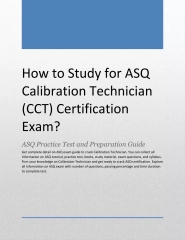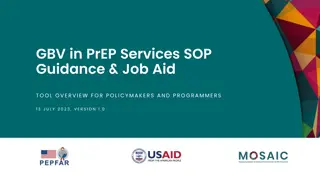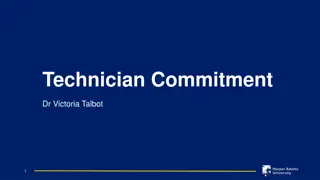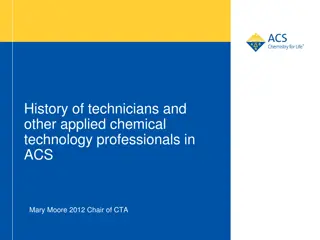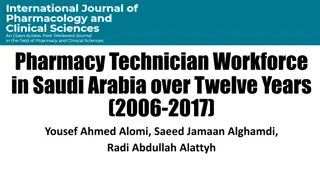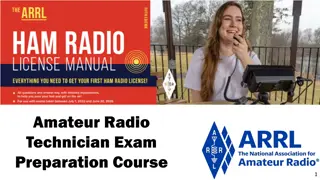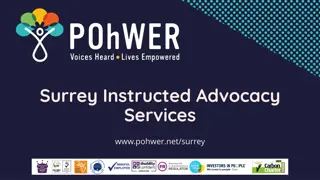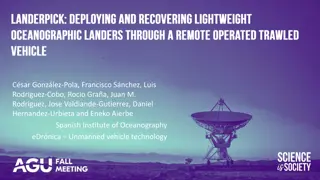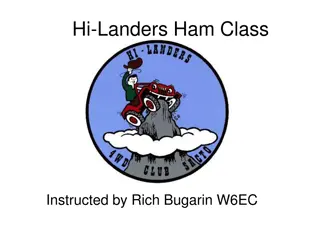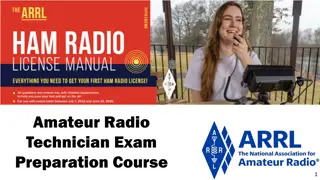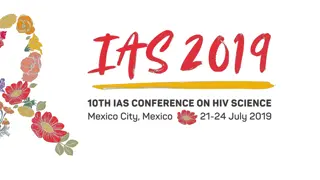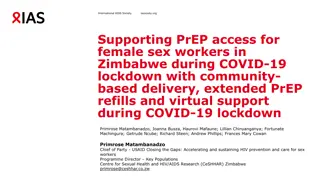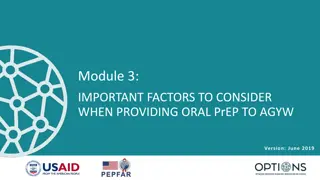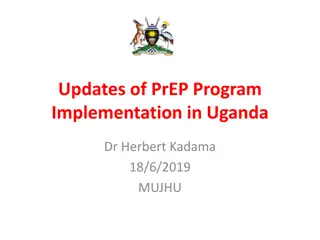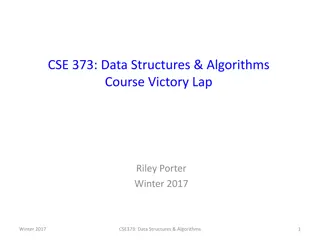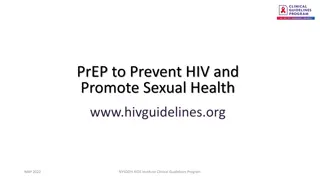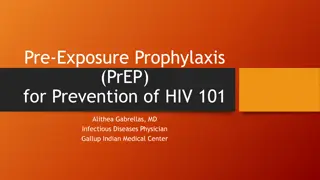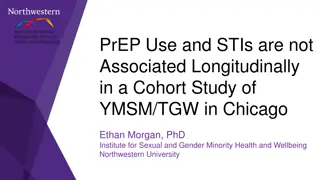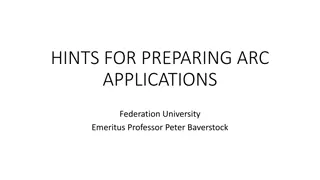Hi-Landers Ham Class instructed by Rich Bugarin - Study Hints & Technician Exam Prep
Explore the Hi-Landers Ham Class instructed by Rich Bugarin, W6EC, with study hints for effective exam preparation. Dive into FCC Element 2 exam questions, FCC rules, and definitions for the Amateur Radio Service. Enhance your understanding with insights on the purpose of the Amateur Radio Service and operator responsibilities. Discover valuable tips for tackling exam questions and maximizing your success in the Technician Class exam. Prepare with focus and precision using the provided resources to excel in your Ham Radio endeavors.
Download Presentation

Please find below an Image/Link to download the presentation.
The content on the website is provided AS IS for your information and personal use only. It may not be sold, licensed, or shared on other websites without obtaining consent from the author.If you encounter any issues during the download, it is possible that the publisher has removed the file from their server.
You are allowed to download the files provided on this website for personal or commercial use, subject to the condition that they are used lawfully. All files are the property of their respective owners.
The content on the website is provided AS IS for your information and personal use only. It may not be sold, licensed, or shared on other websites without obtaining consent from the author.
E N D
Presentation Transcript
Hi-Landers Ham Class Instructed by Rich Bugarin W6EC
Ham Radio Technician Class Exam preparation Power Point created by Rich Bugarin W6EC. Effective July 1, 2022 and is valid until June 30, 2026. Please send suggested changes to this presentation to: w6ec@thebugarins.com
Study Hints I suggest you read each question and only the correct answer. Read through the complete question pool at least three times before you attempt taking a practice exams. For higher impact and better results read the correct answer first then the question and again the correct answer. The key to passing the exam is to get the most questions correct using the above method the correct response will often jump out at you on test day even if you don t remember the question.
Text Color Black: Original/Official questions and information in original format (unaltered). Red: Original information text color simply changed to highlight subject. Blue: Notes and information added by Rich (W6EC).
2022 Technician Class (FCC Element 2) 35 Exam questions
SUBELEMENT T1 FCC Rules, descriptions, and definitions for the Amateur Radio Service, operator and station license responsibilities [6 Exam Questions - 6 Groups]
T1A - Amateur Radio Service: purpose and permissible use of the Amateur Radio Service, operator/primary station license grant; Meanings of basic terms used in FCC rules; Interference; RACES rules; Phonetics; Frequency Coordinator #1 of 35
T1A01 [97.1] Which of the following is a purpose of the Amateur Radio Service as stated in the FCC rules and regulations? A. Providing personal radio communications for as many citizens as possible B. Providing communications for international non- profit organizations C. Advancing skills in the technical and communication phases of the radio art D. All of these choices are correct
T1A01 [97.1] Which of the following is a purpose of the Amateur Radio Service as stated in the FCC rules and regulations? A. Providing personal radio communications for as many citizens as possible B. Providing communications for international non- profit organizations C. Advancing skills in the technical and communication phases of the radio art D. All of these choices are correct
T1A02 [97.1] What agency regulates and enforces the rules for the Amateur Radio Service in the United States? A. FEMA B. Homeland Security C. The FCC D. All these choices are correct
T1A02 [97.1] What agency regulates and enforces the rules for the Amateur Radio Service in the United States? A. FEMA B. Homeland Security C. The FCC D. All these choices are correct
T1A03 [97.119(b)(2)] What are the FCC rules regarding the use of a phonetic alphabet for station identification in the Amateur Radio Service? A. It is required when transmitting emergency messages B. It is encouraged C. It is required when in contact with foreign stations D. All these choices are correct
T1A03 [97.119(b)(2)] What are the FCC rules regarding the use of a phonetic alphabet for station identification in the Amateur Radio Service? A. It is required when transmitting emergency messages B. It is encouraged C. It is required when in contact with foreign stations D. All these choices are correct
T1A04 [97.5(b)(1)] How many operator/primary station license grants may be held by any one person? A. One B. No more than two C. One for each band on which the person plans to operate D. One for each permanent station location from which the person plans to operate
T1A04 [97.5(b)(1)] How many operator/primary station license grants may be held by any one person? A. One B. No more than two C. One for each band on which the person plans to operate D. One for each permanent station location from which the person plans to operate
T1A05 [97.7] What proves that the FCC has issued an operator/primary license grant? A. A printed copy of the certificate of successful completion of examination B. An email notification from the NCVEC granting the license C. The license appears in the FCC ULS database D. All these choices are correct
T1A05 [97.7] What proves that the FCC has issued an operator/primary license grant? A. A printed copy of the certificate of successful completion of examination B. An email notification from the NCVEC granting the license C. The license appears in the FCC ULS database D. All these choices are correct
T1A06 [97.3(a)(9)] What is the FCC Part 97 definition of a "beacon"? A. A government transmitter marking the amateur radio band edges B. A bulletin sent by the FCC to announce a national emergency C. A continuous transmission of weather information authorized in the amateur bands by the National Weather Service D. An amateur station transmitting communications for the purposes of observing propagation or related experimental activities
T1A06 [97.3(a)(9)] What is the FCC Part 97 definition of a "beacon"? A. A government transmitter marking the amateur radio band edges B. A bulletin sent by the FCC to announce a national emergency C. A continuous transmission of weather information authorized in the amateur bands by the National Weather Service D. An amateur station transmitting communications for the purposes of observing propagation or related experimental activities
T1A07 [97.3(a)(41)] What is the FCC Part 97 definition of a "space station"? A. Any satellite orbiting the Earth B. A manned satellite orbiting the Earth C. An amateur station located more than 50 km above the Earth's surface D. An amateur station using amateur radio satellites for relay of signals
T1A07 [97.3(a)(41)] What is the FCC Part 97 definition of a "space station"? A. Any satellite orbiting the Earth B. A manned satellite orbiting the Earth C. An amateur station located more than 50 km above the Earth's surface D. An amateur station using amateur radio satellites for relay of signals
T1A08 [97.3(a)(22)] Which of the following entities recommends transmit/receive channels and other parameters for auxiliary and repeater stations? A. Frequency Spectrum Manager appointed by the FCC B. Volunteer Frequency Coordinator recognized by local amateurs C. FCC Regional Field Office D. International Telecommunications Union
T1A08 [97.3(a)(22)] Which of the following entities recommends transmit/receive channels and other parameters for auxiliary and repeater stations? A. Frequency Spectrum Manager appointed by the FCC B. Volunteer Frequency Coordinator recognized by local amateurs C. FCC Regional Field Office D. International Telecommunications Union
T1A09 [97.3(a)(22)] Who selects a Frequency Coordinator? A. The FCC Office of Spectrum Management and Coordination Policy B. The local chapter of the Office of National Council of Independent Frequency Coordinators C. Amateur operators in a local or regional area whose stations are eligible to be repeater or auxiliary stations D. FCC Regional Field Office
T1A09 [97.3(a)(22)] Who selects a Frequency Coordinator? A. The FCC Office of Spectrum Management and Coordination Policy B. The local chapter of the Office of National Council of Independent Frequency Coordinators C. Amateur operators in a local or regional area whose stations are eligible to be repeater or auxiliary stations D. FCC Regional Field Office
T1A10 [97.3(a)(38), 97.407] What is the Radio Amateur Civil Emergency Service (RACES)? A. A radio service using amateur frequencies for emergency management or civil defense communications B. A radio service using amateur stations for emergency management or civil defense communications C. An emergency service using amateur operators certified by a civil defense organization as being enrolled in that organization D. All these choices are correct
T1A10 [97.3(a)(38), 97.407] What is the Radio Amateur Civil Emergency Service (RACES)? A. A radio service using amateur frequencies for emergency management or civil defense communications B. A radio service using amateur stations for emergency management or civil defense communications C. An emergency service using amateur operators certified by a civil defense organization as being enrolled in that organization D. All these choices are correct
T1A11 [97.101 (d)] When is willful interference to other amateur radio stations permitted? A. To stop another amateur station that is breaking the FCC rules B. At no time C. When making short test transmissions D. At any time, stations in the Amateur Radio Service are not protected from willful interference
T1A11 [97.101 (d)] When is willful interference to other amateur radio stations permitted? A. To stop another amateur station that is breaking the FCC rules B. At no time C. When making short test transmissions D. At any time, stations in the Amateur Radio Service are not protected from willful interference
T1B - Authorized frequencies: frequency allocations; ITU; emission modes; restricted sub-bands; spectrum sharing; transmissions near band edges; contacting the International Space Station; power output #2 of 35
T1B01 [97.301 (e)] Which of the following frequency ranges are available for phone operation by Technician licensees? A. 28.050 MHz to 28.150 MHz B. 28.100 MHz to 28.300 MHz C. 28.300 MHz to 28.500 MHz D. 28.500 MHz to 28.600 MHz
T1B01 [97.301 (e)] Which of the following frequency ranges are available for phone operation by Technician licensees? A. 28.050 MHz to 28.150 MHz B. 28.100 MHz to 28.300 MHz C. 28.300 MHz to 28.500 MHz D. 28.500 MHz to 28.600 MHz
T1B02 [97.301, 97.207(c)] Which amateurs may contact the International Space Station (ISS) on VHF bands? A. Any amateur holding a General class or higher license B. Any amateur holding a Technician class or higher license C. Any amateur holding a General class or higher license who has applied for and received approval from NASA D. Any amateur holding a Technician class or higher license who has applied for and received approval from NASA
T1B02 [97.301, 97.207(c)] Which amateurs may contact the International Space Station (ISS) on VHF bands? A. Any amateur holding a General class or higher license B. Any amateur holding a Technician class or higher license C. Any amateur holding a General class or higher license who has applied for and received approval from NASA D. Any amateur holding a Technician class or higher license who has applied for and received approval from NASA
T1B03 [97.301(a)] Which frequency is within the 6 meter band? A. 49.00 MHz B. 52.525 MHz C. 28.50 MHz D. 222.15 MHz
T1B03 [97.301(a)] Which frequency is within the 6 meter band? A. 49.00 MHz B. 52.525 MHz C. 28.50 MHz D. 222.15 MHz Logical answers must be close to this number 50. In this case it is the closest higher answer. Observation often the correct Frequency ends in a .525 Using Math 300 6 (Meters) = 50 (MHz)
T1B04 [97.301(a)] Which amateur band includes 146.52 MHz? A. 6 meters B. 20 meters C. 70 centimeters D. 2 meters
T1B04 [97.301(a)] Which amateur band includes 146.52 MHz? A. 6 meters B. 20 meters C. 70 centimeters D. 2 meters meter frequency the Hi- Landers use Math 300 146.52 = 2.0475 Rounded off = 2 meters But also note 146.525 is the 2
T1B05 [97.305(c)] How may amateurs use the 219 to 220 MHz segment of 1.25 meter band? A. Spread spectrum only B. Fast-scan television only C. Emergency traffic only D. Fixed digital message forwarding systems only
T1B05 [97.305(c)] How may amateurs use the 219 to 220 MHz segment of 1.25 meter band? A. Spread spectrum only B. Fast-scan television only C. Emergency traffic only D. Fixed digital message forwarding systems only See ARRL Technician Privileges hand out
T1B06 [97.301(e), 97.305] On which HF bands does a Technician class operator have phone privileges? A. None B. 10 meters only C. 80 meters, 40 meters, 15 meters and 10 meters D. 30 meters only
T1B06 [97.301(e), 97.305] On which HF bands does a Technician class operator have phone privileges? A. None B. 10 meters only C. 80 meters, 40 meters, 15 meters and 10 meters D. 30 meters only Long meters like 80, 40, 20, 10 Tech only has privileges on 10m HF = High Frequency
T1B07 [97.305(a), (c)] Which of the following VHF/UHF band segments are limited to CW only? A. 50.0 MHz to 50.1 MHz and 144.0 MHz to 144.1 MHz B. 219 MHz to 220 MHz and 420.0 MHz to 420.1 MHz C. 902.0 MHz to 902.1 MHz D. All these choices are correct
T1B07 [97.305(a), (c)] Which of the following VHF/UHF band segments are limited to CW only? A. 50.0 MHz to 50.1 MHz and 144.0 MHz to 144.1 MHz B. 219 MHz to 220 MHz and 420.0 MHz to 420.1 MHz C. 902.0 MHz to 902.1 MHz D. All these choices are correctv Note two groups of frequencies with .0 to .1 both groups
T1B08 [97.303] How are US amateurs restricted in segments of bands where the Amateur Radio Service is secondary? A. U.S. amateurs may find non-amateur stations in those segments, and must avoid interfering with them B. U.S. amateurs must give foreign amateur stations priority in those segments C. International communications are not permitted in those segments D. Digital transmissions are not permitted in those segments
T1B08 [97.303] How are US amateurs restricted in segments of bands where the Amateur Radio Service is secondary? A. U.S. amateurs may find non-amateur stations in those segments, and must avoid interfering with them B. U.S. amateurs must give foreign amateur stations priority in those segments C. International communications are not permitted in those segments D. Digital transmissions are not permitted in those segments
T1B09 [97.101(a), 97.301(a-e)] Why should you not set your transmit frequency to be exactly at the edge of an amateur band or sub-band? A. To allow for calibration error in the transmitter frequency display B. So that modulation sidebands do not extend beyond the band edge C. To allow for transmitter frequency drift D. All of these choices are correct
T1B09 [97.101(a), 97.301(a-e)] Why should you not set your transmit frequency to be exactly at the edge of an amateur band or sub-band? A. To allow for calibration error in the transmitter frequency display B. So that modulation sidebands do not extend beyond the band edge C. To allow for transmitter frequency drift D. All of these choices are correct
T1B10 [97.305(c)] Where may SSB phone be used in amateur bands above 50 MHz? A. Only in sub-bands allocated to General class or higher licensees B. Only on repeaters C. In at least some segment of all these bands D. On any band if the power is limited to 25 watts


